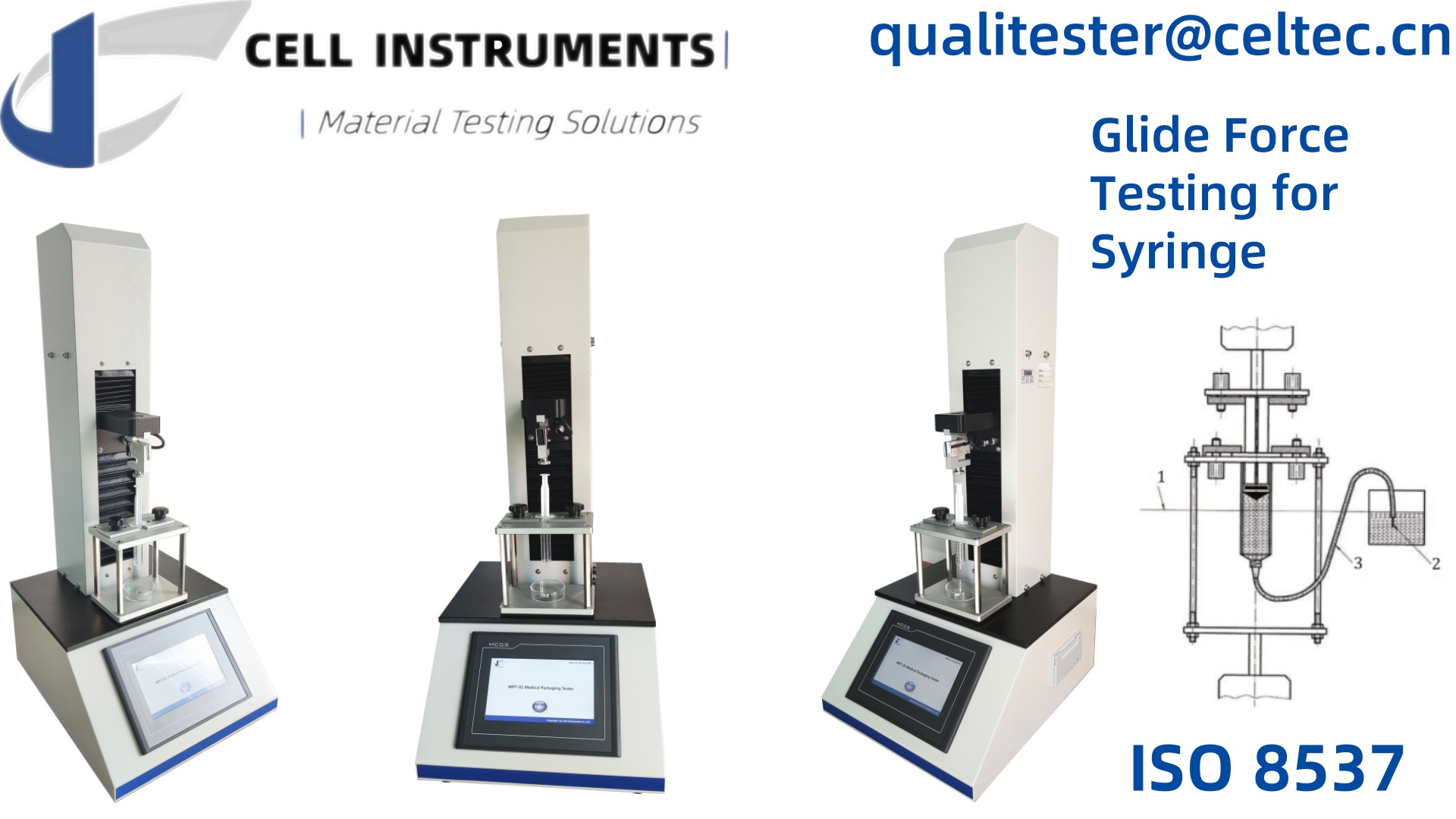في الصناعات الطبية والصيدلانية، تلعب وظيفة المحقنة دورًا حاسمًا في ضمان توصيل الدواء بشكل آمن وفعال. يعد اختبار قوة انزلاق المحقنة أحد أهم الاختبارات في تقييم أداء المحقنة. يقيس هذا الاختبار القوة المطلوبة لتحريك مكبس المحقنة، وهو عامل حاسم في قابلية استخدام الجهاز وموثوقيته. يعد فهم الإجراءات والمعايير وأهمية هذا الاختبار أمرًا ضروريًا للمصنعين للامتثال للمتطلبات التنظيمية والحفاظ على جودة المنتج.
ما هو اختبار قوة انزلاق المحقنة؟
اختبار قوة انزلاق المحقنة، المعروف أيضًا باسم "القوة اللازمة لبدء حركة المكبس"يقيس هذا الاختبار القوة المطلوبة لتحريك المكبس داخل أسطوانة المحقنة. يعد هذا الاختبار بالغ الأهمية لضمان تشغيل المحقنة بسلاسة وثبات، وهو أمر ضروري لراحة المستخدم ودقة الدواء. يساعد الاختبار في تحديد مشكلات مثل الاحتكاك المفرط بين مكبس المحقنة والأسطوانة، مما قد يسبب عدم الراحة أو يعيق عملية توصيل الدواء.
لماذا يعد اختبار قوة انزلاق المحقنة مهمًا؟
يضمن اختبار قوة الانزلاق أن المحاقن تتمتع بتوازن مثالي للمقاومة، مما يمنع الحاجة إلى قوة قليلة جدًا أو كبيرة جدًا لتشغيل المكبس. قد تؤدي المقاومة غير الكافية إلى حركة غير مقصودة، في حين أن المقاومة المفرطة قد تؤدي إلى صعوبات في الإدارة، مما قد يتسبب في إحباط المستخدم أو حتى أخطاء في الدواء. من خلال إجراء هذا الاختبار، يمكن للمصنعين التأكد من أن المحاقن آمنة وسهلة الاستخدام وتلبي معايير الصناعة.
ISO 8537 واختبار قوة الانزلاق
ال ايزو 8537 توفر هذه المواصفة إرشادات لتقييم القوة المطلوبة لتشغيل مكبس المحقنة. كما تحدد طريقة الاختبار وتحدد المعدات والإجراءات اللازمة لضمان نتائج اختبار دقيقة وموثوقة. تعد هذه المواصفة ضرورية للمصنعين للالتزام بها لتلبية المتطلبات التنظيمية، وضمان أداء محاقنهم ضمن الحدود المقبولة للسلامة والفعالية.
فهم إجراءات الاختبار
وفقًا لإرشادات ISO 8537، يتم إجراء اختبار قوة انزلاق المحقنة عادةً باستخدام آلة اختبار ميكانيكية. تطرد هذه الآلة الماء من المحقنة بينما تسجل في نفس الوقت القوة المطلوبة لتحريك المكبس. تتضمن الخطوات الرئيسية في العملية ما يلي:
- تحضير:يتم ملء المحقنة بالماء حتى 50% من سعتها الاسمية.
- تطبيق القوة:يتم تثبيت المحقنة بشكل آمن في مكانها، ويتم تطبيق قوة لأسفل على المكبس باستخدام مقياس القوة.
- قياس:يتم تسجيل القوة المطلوبة لبدء حركة المكبس، إلى جانب الحد الأقصى للقوة اللازمة للضغط على المكبس بالكامل.
تضمن هذه الخطوات قياسًا ثابتًا ودقيقًا لقوة الانزلاق، مما يوفر بيانات قيمة لمراقبة الجودة والامتثال.
دور جهاز اختبار الحقنة الطبية MST-01
بالنسبة للمصنعين الذين يبحثون عن الدقة وسهولة الاستخدام في اختباراتهم، فإن جهاز اختبار الحقنة الطبية MST-01 هو الحل الأمثل. يوفر جهاز الاختبار المتقدم هذا مجموعة من الميزات التي تجعله مناسبًا للغاية لإجراء اختبارات قوة انزلاق الحقنة بما يتماشى مع ISO 8537 والمعايير الأخرى ذات الصلة.
يتضمن MST-01 ما يلي:
- برامج اختبار متعددة لإجراء مجموعة متنوعة من اختبارات الحقنة، بما في ذلك اختبار قوة الانزلاق.
- التحكم الدقيق في الإزاحة استخدام آلية الكرة اللولبية للقياس الدقيق.
- سرعات الاختبار المتغيرة، مما يسمح للمستخدمين بتخصيص معلمات الاختبار استنادًا إلى أنواع الحقن المحددة.
- واجهة سهلة الاستخدام مع شاشة تعمل باللمس مقاس 7 بوصات لسهولة التشغيل.
- تسجيل البيانات في الوقت الحقيقي ويتم إخراج البيانات من خلال طابعة صغيرة أو واجهة RS232 اختيارية للحصول على تقارير مفصلة.
من خلال استخدام جهاز اختبار الحقنة الطبية MST-01، يمكن للمصنعين ضمان نتائج متسقة وموثوقة، وتحسين جودة المنتج وتلبية معايير الاختبار الدولية.
الفوائد الرئيسية لاختبار قوة انزلاق المحقنة
- ضمان السلامة:يضمن اختبار قوة الانزلاق سهولة استخدام المحاقن، مما يقلل من خطر توصيل الدواء بشكل غير صحيح بسبب الفشل الميكانيكي.
- الامتثال التنظيمي:إن اتباع معايير مثل ISO 8537 يساعد الشركات المصنعة على تلبية المتطلبات التنظيمية لوظيفة المحقنة.
- تجربة المستخدم:تضمن قوة انزلاق المحقنة المعايرة بشكل صحيح تجربة أكثر سلاسة لمقدمي الرعاية الصحية والمرضى على حد سواء.
- ضبط الجودة:يساعد الاختبار المتسق على تحديد عيوب التصميم المحتملة في الحقن، مما يؤدي إلى تحسين تطوير المنتجات وعمليات التصنيع.
يعد اختبار قوة انزلاق المحقنة إجراءً أساسيًا لتقييم أداء المحقنة، مما يضمن تشغيل المحقنة بشكل ثابت وسلس وآمن. يعد الامتثال لمعايير ISO 8537 أمرًا ضروريًا للشركات المصنعة التي تهدف إلى تلبية لوائح الصناعة وتقديم منتجات عالية الجودة إلى السوق. باستخدام معدات الاختبار المتقدمة مثل جهاز اختبار المحقنة الطبية MST-01، يمكن للشركات تبسيط عمليات الاختبار الخاصة بها، مما يضمن الموثوقية والسلامة في منتجات المحقنة الخاصة بها.
الأسئلة الشائعة
1. ما هو الغرض من اختبار قوة انزلاق المحقنة؟
يقيس اختبار قوة انزلاق المحقنة القوة المطلوبة لتحريك مكبس المحقنة، مما يضمن التشغيل السلس والمتسق. وهذا أمر بالغ الأهمية لراحة المستخدم وتوصيل الدواء بدقة.
2. كيف يتم إجراء اختبار قوة الانزلاق؟
يتضمن الاختبار ملء المحقنة بالماء، وتثبيتها على جهاز اختبار، وتطبيق قوة لأسفل على المكبس أثناء تسجيل القوة المطلوبة لتحريكه.
3. ما هو ISO 8537، ولماذا هو مهم؟
ISO 8537 هو المعيار الدولي الذي يوفر إرشادات لاختبار القوة المطلوبة لتشغيل مكبس المحقنة. ويضمن أن المحاقن تلبي المتطلبات التنظيمية للسلامة والوظائف.
4. كيف يساعد جهاز اختبار الحقنة الطبية MST-01 في اختبار قوة الانزلاق؟
يوفر جهاز MST-01 تحكمًا دقيقًا في الإزاحة، وسرعات متغيرة، وبرامج اختبار متعددة، مما يجعله أداة مثالية لإجراء اختبارات دقيقة لقوة انزلاق المحقنة بما يتماشى مع ISO 8537.
5. ماذا يحدث إذا فشلت المحقنة في اختبار قوة الانزلاق؟
إذا فشلت المحقنة في اختبار قوة الانزلاق، فهذا يشير إلى أن المكبس قد يكون صعبًا للغاية أو سهلًا للغاية للتحرك، مما قد يؤدي إلى حدوث مشكلات أثناء الحقن. يلزم إجراء المزيد من تعديلات التصميم أو تحسينات الجودة لتلبية معايير الصناعة.
منتج ذو صلة
جهاز اختبار قوة انزلاق مكبس المحقنة
مقالة ذات صلة
اختبار قوة انزلاق مكبس المحقنة
اختبار قوة انزلاق مكبس المحقنة

